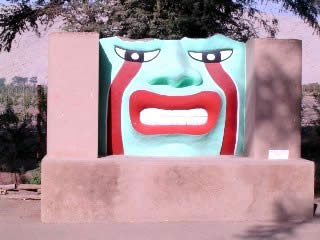ARCHEOLOGICAL SITE MOJEQUE (MOXEQUE)
AND
"PAMPA DE LLAMAS"

MOJEQUE - MOXEQUE - SCALE MODEL OF CASMA REGIONAL MUSEUM
This Complex brings lights on urbanism in the Andean Area, exhibiting good planning in the distribution of its constructive units and the organization of space occupied.
LOCATION
It is located 16 km from Casma, following the road to Huaraz, about 2 km beyond the diversion leading to the archaeological site of Sechin, there is a dirt road bordering a hill; then 7 km across Pampa Rosario, before reaching the village of Moxeke (Mojeque).
Another form of locating Mojeque is that it lies south of the range San Francisco, in the right bank of river Casma, in a floodplain with more than 50 hectares.
Access is by a diversion of the road Casma-Huar?z, parting from a granite spur at the east side of Laguna hill, then crossing the canal irrigation Sechin that ends in pampa El Rosario; moving eastward a gorge is found, formed by the San Francisco and Mucho Malo hills; crossing it appears the archaeological complex.
THE ARCHAEOLOGICAL SITE
Since 1937, when Julio C. Tello made the split, the Sector South is known as Pampa de Llamas, while Mojeque is the north sector. In fact, Pampa de Llamas and Mojeque are parts of the same town that result from a very early planning in the basin of Casma.
SECTOR PAMPA DE LLAMAS
It consists of many buildings made of stone and adobe (conical, trunk-conical and parallelepipeds), where stands a large building named by Tello: Waka A, a rectangular plant, composed of precincts ordered as a chess-board, with side entrances, and well-communicated.
At the side of the large building there are two semi-sunken squares framed by staggered walls. The square at the NE side continues onto a small enclosure almost rectangular, with a circular well in its center.
The building was a big palace made with conical adobe and stones joined with mud mortar; the walls carefully plastered have mural paintings and polychrome reliefs in the facade of the main settings, as the incomplete characters discovered by Thomas Pozorski. Besides, the curve corners present in repetitive form and stone sculpture representing a hand and a bifid snake, are reminiscent of the Sechin style of architecture and sculpture, to which is culturally related.
It is important to notice that this Palace and the Temple of Mojeque are in the same corridor and linked by five contiguous squares between the two, ensuring the unity of the archaeological site.
Adjoin to the Palace are several square places with curved corners and dependent on it. It also highlights the planned disposal of two sets of extensive construction, lateral and equidistant to the Palace, formed by small temples, worship places, courtyards, streets, homes and warehouses. Certainly they did proper planning.
Southwest to the Palace crosses a pre-Hispanic road formed by two stone rows, which starts at the foot of Cerro San Francisco and ends in the archeological city El Purgatorio, of Wari affiliation.
Beyond this road and in the perimeter of a square there are traces of meanders corresponding to former agricultural furrows, probably Chimu.
Most of its buildings belong to the Early Formative Period, with an antiquity of more than 1700 years and are Sechin. There are also constructions of influence, Santa, Wari, Chimu and Casma-Chimu.
MOJEQUE SECTOR
It is another site with wide plazas, housing units, terraces, cemeteries, highlighting a great pyramid, whose terraces are communicated through stairways from the main entrance to the Northwest side.
The pyramid was built with stones and mud mortar, although they also used conical adobes that appear above the third platform. It has a square, curved corners, and is approximately 170 m. per side and more than 25 m. tall.
The first staircase leads to a platform where there is a large lobby, then starts another staircase that leads to an interior gallery, where there is a square with curved corners. High up there are other high terraces with poorly maintained structures. The walls of the pyramid were plastered and decorated with polychrome reliefs, mural painting and must have had engraved stones.
But what is really spectacular of Moxeke lies in the so-called idols and other polychromatic images, found in the third platform which is divided by a lobby. Tello discovered at the right side six huge idols made of stones and mud inside large niches of 3.90 m. tall. These polychrome reliefs show human motives, represent faces and upper middle bodies, among them there are other intercalated reliefs, incomplete, with snake-like designs of partially destroyed figures.

MOJEQUE - REPLICA OF MULTICOLOR POLYCHROME IDOL TO NORMAL SIZE
They used the colors: red, green-emerald, blue, black, yellow and other shades.

MOJEQUE - MULTICOLOR IDOL

MOJEQUE - MULTICOLOR IDOL
This monumental architecture and sculpture in the style Sechin, was one of the most important temples in the area. It belongs to the Early Formative Period and is 3700 years old.
Source: Series Arqueologica N? 12
Page translated by courtesy of: Carlos Dextre.
Página web creada el 30 de marzo del 2005.
© Copyright 2005 Gualberto Valderrama C.
|
 SPANISH
SPANISH

 SPANISH
SPANISH
